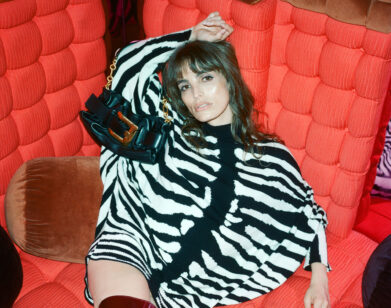Disco’s Not Dead: The Return of Halston

30 years after the fall of disco and 20 after the designer’s death, Halston, the eponymous fashion label of the ‘70s, is back. With a successful high-end debut collection this winter by new creative director Marios Schwab, along with one-woman fashion economy Sarah Jessica Parker signing on for the more contemporary Halston Heritage, the once-forgotten house is on its way back. This was well timed to the premiere of Ultrasuede: In Search of Halston at the Tribeca Film Festival. The film looks at the life and death of both label and designer, and the implosion of his empire after a catastrophic collaboration with JC Penny, a billion-dollar, six-year commitment that was almost immediately discontinued because of poor sales.
Director Whitney Sudley-Smith’s search for the man behind the image reaffirms the image of visionary designer who pioneered what we now know as the disco look. A marked contrast to his carefully-coiffed subject, Sudley-Smith good-naturedly fumbles through his interviews with ’70’s icons like Liza Minelli and Andre Leon Talley. At a post-premiere panel, the director was joined by Talley, Ralph Rucci and Pat Cleveland.
Using simple shapes and luxe fabrics, Halston helped cast off the hippie look in the ’70s, and he was America’s first celebrity designer. Designer Ralph Rucci, whose first job was toiling in Halston’s workshop, described the feeling at the time of the designer’s influence, “It was going to be a new history. You knew it. Working on the clothes, you had never seen patterns like these before. You were asked to execute toiles and you had to think in different dimensions.” Vogue‘s Talley emphasized the American-ness of Halston’s clothing, and its sense of post-war industriousness: “Ultimate quality for the American woman, or the international woman, with style glamour and class is his legacy.” And being an American designer meant American celebrities needed to play a part, he continued, “It was about seeing the clothes. Seeing Lee Radziwill in the incredible bias-cut hammered satin dress with the sarong, attitude, and the decollage. It was about knowing Jackie Onassis was writing little letters to him asking about cantaloupe melon caftans… When you went to see Halston working on the collection, it was like going to Hollywood.”
Although many people have seen the clothes, precious few have gotten to wear them. Model Pat Cleveland described the influence of Studio 54 as a productive, and sensual, one, “I want to say that his clothes were like music. It was like being wrapped in some beautiful tune.” It was a sensuous set of tones, she says, “Part of the fabric would touch a different note on your body and would make you want to move a certain way… That’s how it felt to wear those clothes, they were dancing on your body.”
Addressing the interminable stories about Halston’s drug use and association with Studio 54, Rucci scoffed: “It should be said that, in his country, when people talk about Halston it inevitably gets to the point about him doing cocaine and other drugs. And everyone did drugs… So [Yves] Saint Laurent, he died as a drug addict. Halston did not die as a drug addict…. In this country, to always reduce Halston to some white powdered turtleneck sweater… is ludicrous and insulting.” American myths, cast of your Puritan undertones, Rucci insisted, “It was divine up there on the [Studio 54] balcony.”






